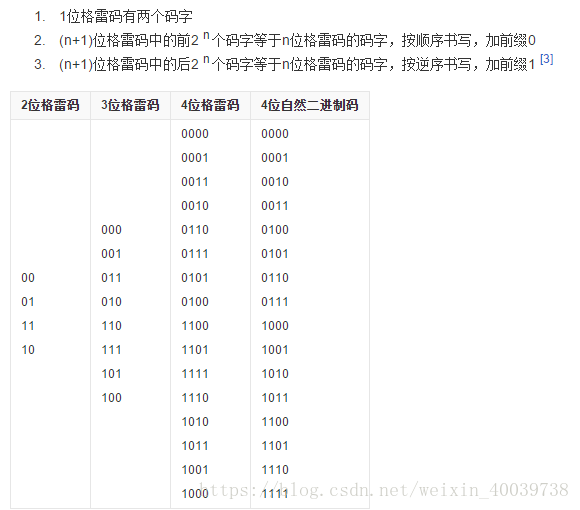题目描述
The gray code is a binary numeral system where two successive values differ in only one bit.
Given a non-negative integer n representing the total number of bits in the code, print the sequence of gray code. A gray code sequence must begin with 0.
For example, given n = 2, return[0,1,3,2]. Its gray code sequence is:
00 - 0
01 - 1
11 - 3
10 - 2
Note:
For a given n, a gray code sequence is not uniquely defined.
For example,[0,2,3,1]is also a valid gray code sequence according to the above definition.
For now, the judge is able to judge based on one instance of gray code sequence. Sorry about that.
格雷码的产生方法一:
以二进制为0值的格雷码为第零项,第一项改变最右边的位元,第二项改变右起第一个为1的位元的左边位元,第三、四项方法同第一、二项,如此反复,即可排列出n个位元的格雷码。
解析 1: 映射法
思路:我们通过对格雷码进行观察,发现格雷码具有映射关系。n位元的格雷码可以从n-1位元的格雷码以上下镜射后(一半顺序,一半逆序再加1<<n)加上新位元的方式快速的得到。我们从一个比特位的格雷码开始计算,直到得到N个比特位的格雷码。第一位是 0 + 1<<0, 0 + 1<<1.
实现代码:
class Solution {
public:
vector<int> grayCode(int n) {
vector<int> ret{0};
for(int i = 0; i < n; i++)
{
int curCnt = ret.size();
//把当前数字按照逆序顺序添加到ret中
while(curCnt)
{
curCnt--;
int curNum = ret[curCnt];
curNum += (1 << i);
ret.push_back(curNum);
}
}
return ret;
}
};
解析2:

解法2不过是返回的是字符串类型
if(n==1)
{
vector<string> v;
v.push_back("0");
v.push_back("1");
return v;
}
else
{
vector<string> v;
vector<string> v1;
v1=gray_code(n-1);
for(int i=0;i<v1.size();i++)
{
v.push_back("0"+v1[i]);
}
for(int i=(v1.size()-1);i>-1;i--)
{
v.push_back("1"+v1[i]);
}
return v;

























 1万+
1万+

 被折叠的 条评论
为什么被折叠?
被折叠的 条评论
为什么被折叠?








